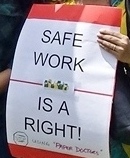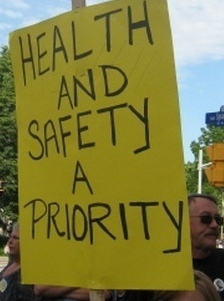|
April 30, 2021 - No. 37 Organizing to Get Results
Major Changes in Mining Methods: the Need to be Proactive in Defending Jobs and Health and Safety
- André Racicot -
André Racicot is the President, USW Local 9291 at the Westwood mine, Abitibi, Quebec
 What comes to mind
is the environment in which we operate, which is
that of underground mines, a very different environment from that of
surface or open pit mines. To be more precise, it is the question of
stabilizing the bedrock within the underground mines which always
concerns us as miners. There have been incidents of underground
mine drifts collapsing. A drift is the horizontal underground
passageway that follows a vein of ore. There are also rock bursts --
large pieces of rock that suddenly break off -- and seismic events. All
of these things are interrelated. What comes to mind
is the environment in which we operate, which is
that of underground mines, a very different environment from that of
surface or open pit mines. To be more precise, it is the question of
stabilizing the bedrock within the underground mines which always
concerns us as miners. There have been incidents of underground
mine drifts collapsing. A drift is the horizontal underground
passageway that follows a vein of ore. There are also rock bursts --
large pieces of rock that suddenly break off -- and seismic events. All
of these things are interrelated.
The Westwood mine whose workers I represent is located, like many
gold mines in Abitibi, along the great geological Cadillac-Larder fault
which stretches over 300 km between Abitibi and Ontario. To extract the
gold-bearing ore you have to dig a mine shaft and drifts at very great
depths. We're talking here about 2,000 to 3,000 metres
underground.
This is why miners, as they open up a mine drift, make sure to
always consolidate the walls and ceiling of the rock face within the
mine drift with anchor bolts and wire mesh. In this construction, they
follow the drawings and specifications prepared by the mine engineer.
To excavate a mine drift, the miners drill holes in what is called
the working face, a vertical surface of the bedrock, which are then
filled with explosive charges. During these operations, the miners
probe the rock and watch for changes in the properties of the rock,
which could be a sign of danger such as a rock burst. The miners use a
scaling
bar to hit the rock face and can detect, just by the sound made by the
rock, if any rocks or parts of the bedrock may break loose.
We often hear about the enormous pressures that exist deep in the
oceans. It's the same with mining: the rock at great depth is under
tremendous pressure and all this energy stored in the bedrock can be
released suddenly when miners dig tunnels and mine drifts to reach a
gold bearing vein. It's called a "rock burst" when the rock breaks up
and explodes.
At Westwood mine we have witnessed five major rock bursts. In the
most recent, last October 30, three mine drifts collapsed and the rock
bursts caused seismic tremors that reached 3.7 on the Richter scale.
One worker was trapped underground for thirty hours.
The health and safety of workers is of great concern, particularly with regard to underground mines.
It is clear that mining methods are set to change.
Currently the mining companies are talking about replacing teams in
the mine drifts by one miner alone operating a drilling machine with an
armoured cabin to open the working face. I believe this kind of
operation would be dangerous in a seismically active zone because I'm
far from being convinced that an armoured cabin would resist a major
rock burst.
More and more, the union and the prevention representatives will
object to doing the work that way. We will demand that operations be
done remotely from the surface in seismic zones.
We are demanding that workers' exposure to risk be reduced. This
means more remote operations, more remote control of operations to
avoid exposing workers to risks.
The companies say that it will be a matter of a job transfer, that
the jobs will still be there, but instead of heavy machinery operators
the workers will be carrying out remote operations. In unionized mines
like ours, we will be able to retain our workers. In the non-unionized
mines, the employers will get rid of the miners and management will
be in charge of remote operations.
 We are closely monitoring all of these changes. We have filed a
proposal that there be a regulation requiring that these operations be
done remotely at the mine site. Employers are raising objections to
this. They argue that already at the Arcelor Mittal open-pit mine in
Fermont, on the Quebec North Shore, huge 200-ton trucks that transport
iron ore are driverless and are remotely controlled by operators whose
workstations are located in Longueil, 1200 km away. The operation could
well be done in another country, in India, in China, anywhere. We are
very concerned, because if this happens, how can we ensure that the
training of workers is adequate. It is important that the operator
be at the mine site so that health and safety regulations that we have
fought for for a long time are enforced, not to mention the regulations
that we managed to put in place at the mine. If we file a complaint
with the Labour Standards, Pay Equity and Workplace Health and Safety
Board (CNESST), they will tell us that they do not have
jurisdiction when remote operations are carried out in another country.
We have already sent the CNESST a letter expressing our concerns about
this new developing situation. Until now, the CNESST has not seen fit
to answer our letter. What we want to ensure is that with the
introduction of these new technologies, the health and safety of
workers comes first. We want to protect our jobs and our health and
safety at those jobs. We are closely monitoring all of these changes. We have filed a
proposal that there be a regulation requiring that these operations be
done remotely at the mine site. Employers are raising objections to
this. They argue that already at the Arcelor Mittal open-pit mine in
Fermont, on the Quebec North Shore, huge 200-ton trucks that transport
iron ore are driverless and are remotely controlled by operators whose
workstations are located in Longueil, 1200 km away. The operation could
well be done in another country, in India, in China, anywhere. We are
very concerned, because if this happens, how can we ensure that the
training of workers is adequate. It is important that the operator
be at the mine site so that health and safety regulations that we have
fought for for a long time are enforced, not to mention the regulations
that we managed to put in place at the mine. If we file a complaint
with the Labour Standards, Pay Equity and Workplace Health and Safety
Board (CNESST), they will tell us that they do not have
jurisdiction when remote operations are carried out in another country.
We have already sent the CNESST a letter expressing our concerns about
this new developing situation. Until now, the CNESST has not seen fit
to answer our letter. What we want to ensure is that with the
introduction of these new technologies, the health and safety of
workers comes first. We want to protect our jobs and our health and
safety at those jobs.
Miners should receive the necessary professional training in order
to face this new reality. At this time this is not happening.
Steelworkers have made representations on this issue for things to
change. I am on the advisory committee of the Val d'Or School Board
which has a vocational program (Diplôme d'études
professionnelles) in ore
mining. I am alerting them to this new situation so that the young
people who will become miners in the future are trained to be able to
deal with the introduction of automated and remote-controlled machinery
in mines.
An essential mechanism for ensuring compliance with health and
safety standards is the prevention representative. I know this from
having been one for 25 years. Our prevention representatives are
appointed by the workers. They act proactively to investigate and
detect problems before they become sources of danger to miners and they
defend
the miners when their health and safety is put at risk. Their role will
become even more important with the changes taking place in the mining
sector.
We are facing a new era in mining operations which requires that the
next generation be well prepared to defend jobs and the health and
safety of all workers.

(To access articles individually click on the black headline.)
PDF
PREVIOUS
ISSUES | HOME
Website: www.cpcml.ca
Email: office@cpcml.ca
|

